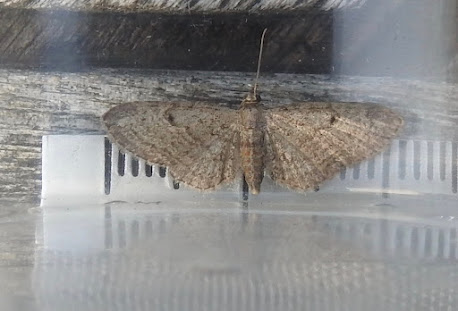Phew, what a scorcher. Dave and I gamely set out into the mid-morning sun, and as temperatures rose to 29 degrees we attempted to record birds.
The furthest flash is now invisible due to the long grass which the cattle in the field would be munching if they weren't all sheltering under an oak tree. The nearest flash is starting to dry out, but still has a healthy balance of water and mud. It also hosted the two Avocets, at least five Green Sandpipers, and not a lot else.
Our only highlights came as we sheltered from the sun in the lee of the hedge bordering the Kingfisher Pool, where Dave spotted a Kingfisher. I caught sight of a movement as it disappeared beneath overhanging trees, and later missed its reappearance entirely because I was concentrating on photographing damselflies.
The dragonflies in question were the first Small Red-eyed Damselflies of the season. Three or four were perching on the algae in the middle of the pool, and at least one had found a mate.
 |
| Small Red-eyed Damselflies |
It was too hot for looking at butterflies. They wouldn't sit still for a second, and although there were plenty, we felt that numbers were lower than in previous years.
Which brings me to Friday night's moths. In contrast to the butterflies, there were an awful lot. 75% of them were micros, and I have spent most of the weekend cataloguing them for posterity. They including four which were nfg (new for the garden) and also lifers for me, and another 17 which were new for the year.
Although the lifers were all micros, one of these was very spectacular, one very rare (well probably cryptic would be a better description), and one from a completely new group bucculatricidae which all meant that I spent a very long time trying to figure out what I was looking at. As ever, @UKMothIdentification helped me out.
Spectacular first. This is a Box-tree Moth, an Asian adventive species accidentally imported into the UK on its food plant, Box, and now a major pest because of its caterpillars' voracious appetites. Although technically a micro, it is huge.
 |
| Box-tree Moth |
I couldn't find it in my Micro-Moth Field Guide because its arrival post-dates publication, but I knew it was from the Crambidae due to its similar size and shape to Mother-of-Pearl, and I quickly found it on the Internet. The moth itself nearly gave me the slip, it had been resting on the outside of the trap and departed as I was carrying the box indoors, before I could get a good look at it. Fortunately it chose to land on the brickwork where I rediscovered it.
The "rare" moth was another one I couldn't find in my moth book. I also couldn't find it on the Internet, and ended up with a very tentative name for it based on something which looked similar.
 |
| Anarsia innoxiella |
I thought my photograph was decent and the moth wasn't especially small as micros go, so I assumed it would not be anything special. It soon got frisky and I opened the back door to let it fly off. Later in the afternoon I decided to Tweet a picture of it captioned with the name I had assigned it. I was put right by @UKMothIdentification, being told it was actually Anarsia innoxiella. Looking up the status of this moth I was startled to learn it was only described for science in 2017. Alarm bells. Actually this was because a couple of experts had looked at specimens of another Anarsia species and had found some that were different. In fact it is apparently the case that innoxiella could be the commoner of the two.
Needless to say I am expecting to be asked whether I retained the specimen. Doh ! Again !
The next new one spent a long time in the fridge while I waited to find out whether my identification was correct. This one was very small, and turned out to be what I thought it was Bucculatrix nigricomella. It still took me a long time to figure out (it also isn't in my field guide).
 |
| Bucculatrix nigricomella |
The last new one was one of the huge tortricidae family, and caused me more headaches. I came up with a very tentative identification of Lobesia abscisana (this one was in the book), and was pleasantly surprised to find that the expert concurred.
 |
| Lobesia abscisana |
I'm determined to keep putting the full trap list on the blog this year, so here goes:
Bucculatrix nigricomella 1 (nfg), Bird-cherry Ermine 17, Yponomeuta ag 2, Brown House Moth 1, Ruddy Streak 2, Anarsia innoxiella 1 (nfg) Coleophora ag 4, Twenty-plume Moth 2, Agapeta hamana 1 (nfy), Aleimma loeflingiana 1, Variegated Golden Tortrix 2, Red-barred Tortrix 5, Clepsis consimilana 1 (nfy), Lobesia abscisana 1 (nfg), Celypha striana 1, Celypha lacunana 3, Bud Moth 1, Codling Moth 8, Cydia splendana 3, Pammene fasciana 2, Phycita roborella 4, Eudonia lacustrata 3 (nfy), Garden Grass-veneer 103, Crambus pascuella 14, Water-veneer 28, Small Magpie 1, Mother-of-Pearl 3 (nfy), Box-Tree Moth 1 (nfg), Leopard Moth 1 (nfy), Elephant Hawk-moth 1, White Satin 1 (nfy), Black Arches 1 (nfy), Common Footman 9, Scarce Footman 2, Treble Brown Spot 1 (nfy), Riband Wave 3, Green Pug 3, V-Pug 2 (nfy), Double-striped Pug 2, September Thorn 1 (nfy), Miller 2 (nfy), Coronet 8, Knot Grass 1, Heart and Dart 3, Uncertain 1, Marbled Minor ag 2, Common Wainscot 2 (nfy), Smoky Wainscot 1 (nfy), Dark Arches 2, Common Rustic ag 1 (nfy), Lesser Broad-bordered Yellow Underwing 1 (nfy), Large Yellow Underwing 3, Double Square-spot 1
So that's 264+ moths (some had to remain unidentified due to wear), of 54 species. Quite a night.




























